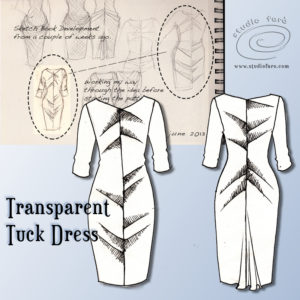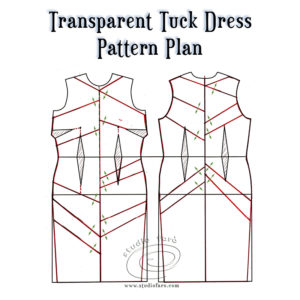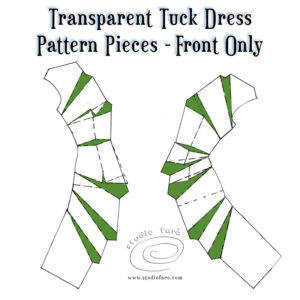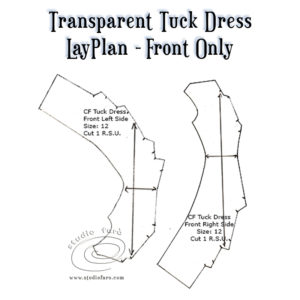30 Apr Transparent Tuck Dress
Congrats to Mioara and Gemma solving the Pattern Puzzle in just one comment! I think I am going to have to up my game to give you all a bit more of a challenge. This creative design is just the kind of pattern we make in my Draped Dresses workshop at Studio Faro. Below is recent design development I have decided to use for the Pattern Puzzle this week. The inspiration comes from Comme de Garcon frock I saw in the late nineties. The image has always stayed with me. I so love their work. This post was originally published 17 June 2013 and is one of my earliest Pattern Puzzle posts. In this post, I have updated the graphics and improved the pattern making instructions for this release.

Working my way through the production sketch gives me time to work out some of the detail in the cutting and making of this dress.
I’ve decided to make the outer shell of the dress in a semi-transparent fabric (black) and the lining of the dress will be either white or a flesh tone. At the point the tucks fold over (centre seams), the three layers of semi-transparent fabric become a solid colour. A fish tail has been added at the back for style for ease of walking. What differs in the production sketch is that I have decided not to put tucks in the sleeves as there is enough going on in the body of this dress already.
Set out below in the pattern plan is my fitted dress block with the side seams equalised and with the position of the tucks indicated by the red lines. You’ll cut through the red lines, from the centre front and back, toward the side seams and armhole. The green arrows show where the pattern will open up to make the large tucks that are the main design feature in this style. The armhole and side seam will stay connected as we open up the CF and CB of the dress for the right and left sides. In the pattern development that follows I’ve only displayed the front of the dress. Pattern development for the back dress is the same but in many ways far simpler as there is no bust dart.

The altered pattern (front only) is set out below with the green areas showing the extra fabric involved in making the tucks. The extra fabric in the pattern is derived from dart transfer, and slash and spread, to add extra fabric where required. There is more detail about my method of drape pattern making here: My Drape Pattern Making Method
I would cut this dress on the bias, based on the grain running perpendicular to the waist. This will place the tucks in the bias part of the fabric and help them drape well. The back dress pattern would be treated in the same manner (as the front) with a side seam zipper for access.

With the first fitting in this draped bias cut dress you may need to tighten the fit through the body of the dress to hold the drape in the tucks. This is common in bias cut drape dresses and each different fabric will require a different amount of alteration to achieve a good fit. These Pattern Puzzles are hypothetical (yet to be fully tested) and are offered simply to inspire your creative pattern making.

Enjoy 🙂
Take this moment to sign up for my fabulous newsletter! Every month or so I send an email newsletter with new website content and always, always an enormous discount code for all my sewing patterns, garment blocks and pattern making instructions.
This discount code is for subscribers only. Don't miss out!


No Comments